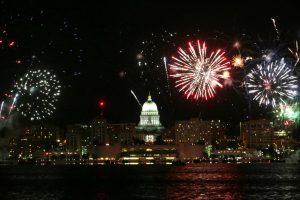
The Fourth of July holiday often is celebrated with community fireworks shows, as well as some backyard fireworks. Fireworks have a broad range of good weather conditions in which to be set off and viewed.
Rain has multiple possible effects on fireworks. Fireworks get very hot. For example, when lit, the tip of a sparkler has a temperature of 1,200 degrees; so once lit, it would take a very heavy rain to extinguish the firework. Damp conditions from rain can hamper the lighting of some fireworks.
Rockets typically shoot below 300 feet in the air, and bottle rockets are less than 75 feet in the air. It would take an extremely low cloud cover to hamper views. Of course, spectators do not want to get rained on while watching a Fourth of July fireworks show.
High humidity could lead to reduced visibilities as a haze, or fog, could develop on the many particles from the smoke near the ground. The smoke particles can serve as condensation nuclei in humid environments. Very dry conditions may result in cancellations of a fireworks show as a precaution to minimize setting off a fire. This could be the situation in areas undergoing drought conditions.
A strong wind could be a problem, as that can make it difficult to light fireworks. Strong winds can also affect the planned path of the fireworks, sending them in unwanted directions. Winds should be less than about 20 mph to be safe.
The wind direction determines where the smoke from the fireworks travel. You would likely want the wind to carry the smoke away from where people are sitting. Completely calm conditions are also not the best as the smoke can linger over the area.
Whatever the weather, we hope you enjoy the Fourth of July holiday.
Steve Ackerman and Jonathan Martin, professors in the UW-Madison department of atmospheric and oceanic sciences, are guests on WHA radio (970 AM) at 11:45 a.m. the last Monday of each month. Send them your questions at stevea@ssec.wisc.edu or jemarti1@wisc.edu.

